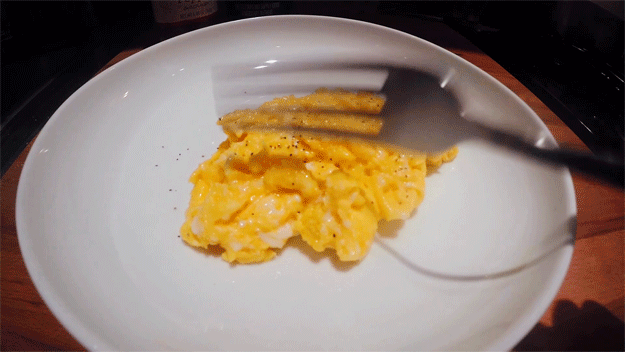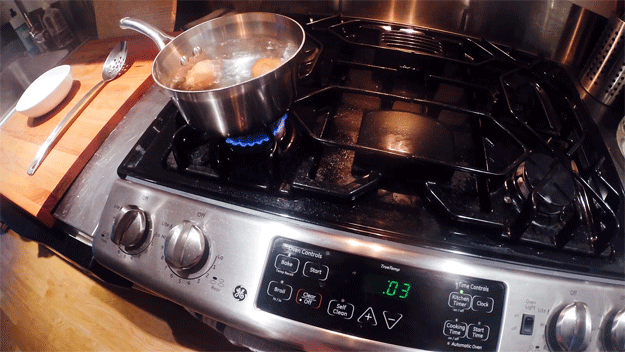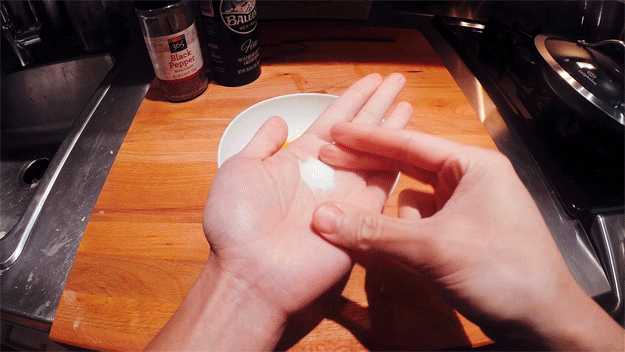I asked Google: “What’s the first thing you should learn how to cook?” and out of the first 100 results, 2 sites answered my question…
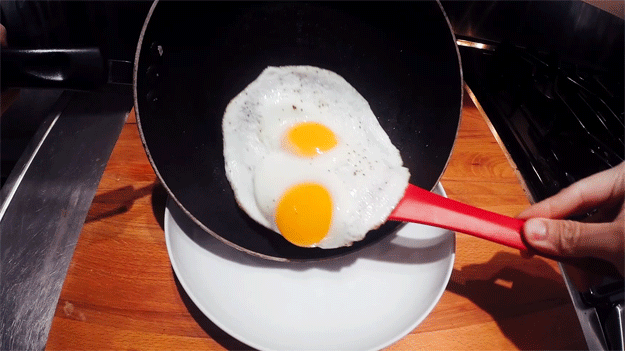
- Eggs were the #1 answer to Family Feud’s question: What’s the 1st food people learn to cook?
- Quora members said that eggs are a good place to learn basic skills.
Luckily, eggs were the first thing I learned to cook. They’re all I made for 7 years because:
- They only take 10 minutes to cook
- They’re inexpensive, so making mistakes isn’t too painful
- They’re not as intimidating as beef/chicken/fish
Below I compiled the best tips & recipes I could find on making eggs 3 ways. Click the links to jump to each recipe.
Fried Eggs
This is a super-easy method to remember. Just think: 1-minute, 1-minute, 1-minute. I made this over 10 times in the past 2 weeks and can confirm that it works great.
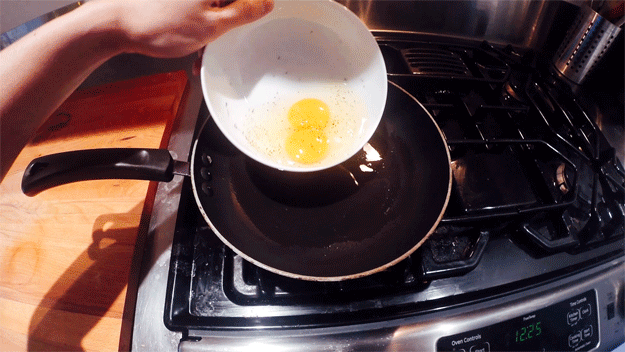
Time: 6 minutes
Makes: 1 serving
Ingredients:
- 1 tablespoon of cooking oil (canola, vegetable, olive, etc.)
- 2 eggs
- Salt and ground black pepper
Steps:
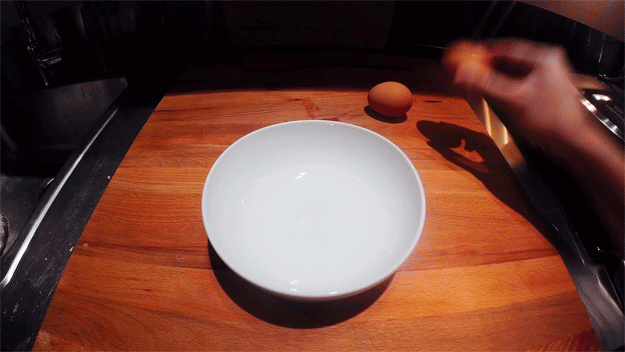
↑ 1. Crack the eggs into a bowl
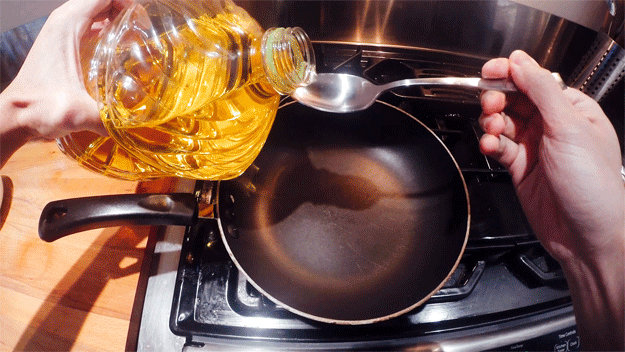
↑ 2. Add 1 tablespoon of oil to a nonstick pan and heat it over medium-high heat for 1 minute. Swirl the oil around the pan so it coats the bottom.

↑ 3. Pour the eggs into the pan and cook for 1 minute.
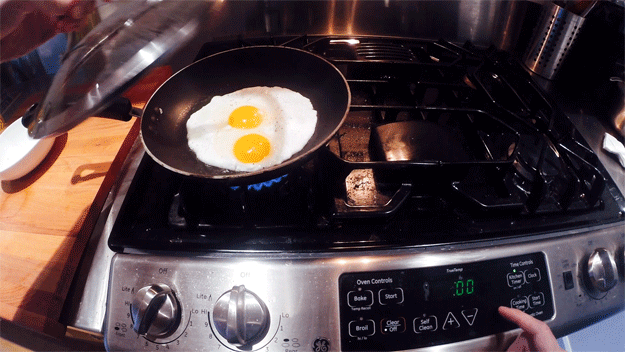
↑ 4. Cover the pan, cook for 1 minute, then turn off the stove. The lid traps heat so the egg also cooks from above, firming up the white before the yolk overcooks.

↑ 5. Move the pan off the heat and leave alone for 1 minute. This allows the whites to finish cooking – gently – while keeping the yolks liquid.

↑ 6. Finally, use a spatula to slide the eggs onto a plate. The whites should be firm and opaque, with a barely cooked yolk. If you like them tougher (less runny), leave them covered for 1 more minute. Enjoy!
Variation: Over-Easy
For a firmer yolk, cook the eggs uncovered for 1-minute, then covered for 1-minute. Then, turn off the heat. Gently flip the eggs with a spatula and leave alone for 1 minute.
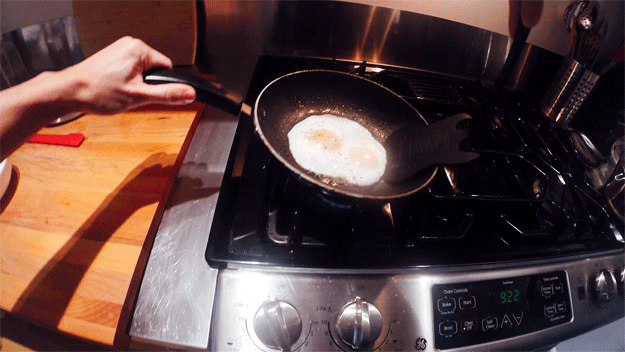
Tip: You can fry as many eggs at a time as will fit comfortably in the pan. Just be sure to increase the amount of oil too.
Resources:
- The steps above are primarily a variation of a Cook’s Illustrated recipe. Shout out to America’s Test Kitchen!
- The Kitchn | How to Fry an Egg
- Food Network | How to Fry Eggs
- Lifehacker | Six Different Ways to Make the Perfect Fried Egg
- Mark Bittman | How to Cook Everything
- I couldn’t find where I originally learned the 1-minute, 1-minute, 1-minute method. If anyone happens to know who made it up, let me know and I can mention it here.
Scrambled Eggs
This Gordon Ramsay video taught me how to make scrambled eggs. It’s funny, educational, and definitely worth a watch.
Time: 10 minutes
Makes: 1 serving
Ingredients:
- 3 Eggs
- Salt and ground black pepper
- 1-2 tablespoons butter
Steps:
- Crack the eggs3 into a nonstick pan4 and add 1 tablespoon of butter.
- Set the pan over medium heat. Immediately start mixing the eggs and butter with a spatula.
- In about 2 minutes, the eggs will begin to curdle5. When you see this, remove the pan from the heat and continue stirring until the cooking slows down a bit. Then after 30 seconds, return the pan to the heat and keep stirring.
- Repeat this 30-seconds-on-the-stove / 30-seconds-off-the-stove process a few times until the eggs are creamy, soft, and still a bit runny. Remember – even after you turn off the heat, the eggs will continue cooking a bit more…
Resources:
- BBC | Perfect Scrambled Eggs
- Alton Brown | Perfect Scrambled Eggs
- Incredible Edible Egg | Stovetop Scrambled Eggs
- Bon Appetit | Tips for the Best Scrambled Eggs Ever
- About | Perfect Scrambled Eggs
- America’s Test Kitchen | The Science of Good Cooking: Master 50 Simple Concepts to Enjoy a Lifetime of Success in the Kitchen
- Mark Bittman | How to Cook Everything: The Basics
Hard & Soft Boiled Eggs
Mrs. B taught me this easy 6-minute method of boiling eggs from The Kitchn.
Time: 10 minutes
Makes: 1 serving
Ingredients:
- 2-3 Eggs
- Salt & ground black pepper
Steps:
1. Fill a pot about halfway with water – enough to cover your eggs.
2. Cover the pot and set it on high heat.
3. When the water starts boiling (about 6 minutes), use a spoon to gently add your eggs to the pot.
4. Adjust the heat so the water bubbles gently (not a hard boil).
5. Set a timer depending on how you like your eggs. Each minute makes a difference, so pay attention
- 3 minutes = completely runny yolk and slightly liquid white
- 4 minutes = white very soft but set
- 6 minutes = cooked but runny yolk; white may be undercooked
- 7 minutes = fully cooked white; some of the yolk may have hardened.
- 8+ minutes = hard boiled.
6. When your timer is up, turn off the heat and bring the pot to the sink and slowly replace the hot water with cold water. Make sure the eggs don’t fall out.
7. Fill the pot with cold water and let it sit on the stove. Cooling the eggs quickly after cooking helps prevent the yolk from developing a (harmless) green ring.
8. After 1 minute, touch the eggs with your fingers. If they feel hot, empty the water from the pan and replace with fresh cold water. When the eggs are cool enough to hold, crack them gently, peel, and sprinkle with salt and pepper.
Resources:
- The Kitchn | How to Soft Boil an Egg
- The Kitchn | How to (Hard) Boil Eggs Perfectly Every Time
- Incredible Egg | Easy Hard-Boiled Eggs
- Mark Bittman’s How to Cook Everything: The Basics
Summary
- The degree of egg-doneness is mainly a matter of timing
- The only real rule is not to overcook them or they will toughen
- It’s easy to avoid toughening – use low heat
- But… you can cook on high heat and still keep eggs tender & soft; it just takes attention.
- Room-temperature eggs will take about 1 minute less to cook than those straight from the refrigerator.
- Fried eggs – add the eggs when the butter is foaming but not yet changing color…or when the oil slides quickly around the pan like water
- Scrambled eggs turn out silkier the more you stir. Control the temperature (keep the heat low) by moving the pan on and off the burner
- Boiled eggs are less like to be damaged in water that bubbles only gently.
Other Cool Resources:
- StackExchange | Different Egg Preparation Methods
- The Kitchn | How to Cook An Egg in Many Ways
- Breakfast With Nick | 11 Ways to Cook an Egg
- Survey: What’s Your Perfect Omelette? (Popular: Cheese, Bacon/Sausage, Bell Peppers/Mushrooms)
- Featured Photo Credit: Autumn Mott (https://unsplash.com/photos/YLyxXawZm4w)
It’s like when you’re kid. First you learn to control your arms and legs, then you crawl. Then you learn how to keep your balance, then you walk. Then you learn how to run and jump. Once you learn all of these things, you’ll never forget.
Think of cooking in the same way.
To crack an egg, smack the side of the egg definitively – but not too aggressively – on a flat surface, stopping your hand when you hear the shell crack.
How to Crack an Egg – Smack the side of the egg definitively – but not too aggressively – on a flat surface, stopping your hand when you hear the shell crack. This helps keep egg shell bits from getting into your food.
Choosing the right pan – Pan size is important when scrambling eggs. If the pan is too large, the eggs spread out in too thin a layer and overcook. A smaller pan forces you to mound the eggs on top of each other, which traps steam and ensures tender, fluffy eggs.
 Source: Butter Than Toast
Source: Butter Than Toast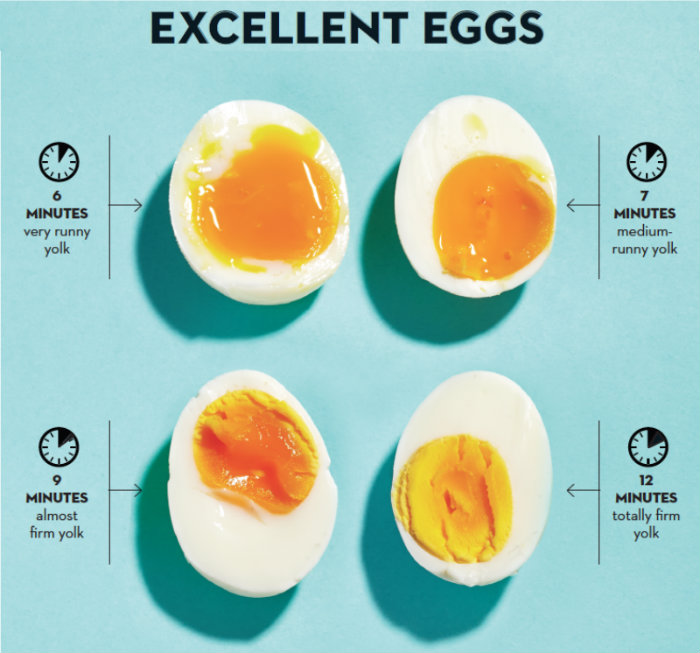 Source: Chatelaine
Source: Chatelaine


